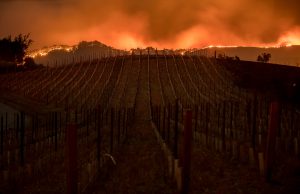The pleasure of sipping wines from France’s esteemed Burgundy region knows no bounds. While it isn’t a large region in regards to size, it’s huge in the wine world. Some of the most expensive wines hail from here though not every bottle from Burgundy will cost a pretty penny.
Burgundy is home to five regions where Chardonnay and Pinot Noir are the stars of this vineyard show. Other varietals are planted here like Pinot Gris, Sauvignon Blanc, Gamay, and Aligoté, but as for what the French call the Bourgogne, red (rouge) production mostly involves Pinot Noir while white (blanc) involves Chardonnay.
What makes these grapes so stand-out among the others? Why, it must be that spectacular terroir upon which Burgundy sits. It lends the wines produced here a most elegant feel that is divinely aromatic and intensely complex. Somewhere around 200 million years ago when Burgundy was in the middle of a warm sea, limestone soil was formed. If you have the pleasure to explore the vineyards yourself, you will see large hunks of limestone, sometimes in the form of marl and mixed with clay. A closer inspection will reveal fossilized remains of creatures from the sea.
Burgundy’s 5 Wine Regions
In this east-central location of France, Burgundy features five distinct wine regions – Chablis, Côte de Nuits, Côte de Beaune, Côte Chalonnaise, and Mâconnais.
– Chablis
At the furthest-north point of Burgundy sits Chablis. It’s quite different from all the other wine growing areas in Burgundy. That’s largely due to the Serein River which helps moderate the climate, which is quite similar to Champagne. In fact, it has the same soil of limestone that’s white and chalky, perfect for both absorbing and reflecting the sun’s warmth to keep the vines ripening. These vines that you see growing here have been thriving since the 12th century when the Cistercian monks first planted them.
This region is well-known for producing Chardonnay with an unoaked flavor. Chablis wines feel pure and crisp on the palate and are absolutely phenomenal.
– Côte de Nuits
If you love Pinot Noir, Côte de Nuits is where you must try it. Here, there are 24 grand cru vineyards among what is deemed the most expensive vineyards in the world. You’ll find Côte de Nuits a little south of Dijon. It spans the region to Corgoloin.
This wine area focuses on Pinot Noir for much of the land while a small portion (roughly 20%) uses the land to cultivate Chardonnay or Rosé. For the grand cru vineyards, you’ll find them on the eastern slopes overlooking the valley at the Saône River. It is here where the Pinot Noir ages for decades, making the price even steeper. Some bottles can cost thousands of dollars, though there are more approachable ones in the way of budget.
Make selection from the premier cru when choosing Pinot Noir and you’ll find something lovely for a special occasion that fits your price point. You’ll be treated to a full-bodied wine with hints of cherry, fresh red fruits, and black currant melded with an earthiness and offset by just the right touch of spice.
– Côte de Beaune
With open, rolling valleys, the vineyards of Côte de Beaune are incredibly different from those just to its north. They face southeastern and the rich Chardonnays from here are completely coveted. In fact, seven out of eight of the grand cru vineyards focus on this particular varietal.
Incidentally, Côte de Nuits and Côte de Beaune are often summed up as one area that means ‘Golden Slope’ or Côte d’Or. This is because they’ve always been the most historically significant in Burgundy. In this ‘Golden Slope,’ the soils were formed from the Jurassic period which were exposed thanks to a fault rupture in the Tertiary era. The different subsoils make it something spectacular. Clay-limestone soils are the legacy of the land and every single plot of land creates unmatched wines with history behind it and impressively unique qualities.
The vines reach deep into the soil, drawing in energy to create wines that have character that runs just as deep. Approachable options for wines from Côte de Beaune include Volnay, Beaune, Pommard, Meursault, and Chassagne-Montratchet, to name a few. Treat yourself to soft floral aromas with hints of fresh apple and pear.
And while the region is revered for whites, don’t sell yourself short by missing out on the reds. You’ll find plummy flavors with that precise minerality Burgundy is so loved for plus good acidity to round it all out.
– Côte Chalonnaise
Continuing further south, Côte Chalonnaise is found between Chagny and Saint-Vallerin. Fascinatingly, this area was regarded by the dukes to be more rural and hence, more for peasants. In the northern portion of Côte Chalonnaise, Bouzeron is devoted to Aligoté varietals which make for lovely and refreshing summer wine drinking. It pairs beautifully with foods of the sea thanks to the floral elements and hints of honeyed citrus. Meanwhile in the center of the region, Rully brings it with Crémant, something it’s been doing since the 19th century in the same fashion as in Champagne.
The villages throughout Côte Chalonnaise are home to varied layers of soil from Jurassic limestone and marl covered with pebbles and clay. In the middle of the region near Givry, there are over 13 different types of soil. It’s no wonder the wines from here are so full of character. They’re also a great value with subtly-oaked Chardonnays and rustic-flavored Pinot Noirs.
– Mâconnais
Furthest south in Burgundy sits Mâconnais. Some dare to call it more ordinary, though it’s really more enduring than anything. When the Great Depression hit and throughout both World Wars, this area suffered deeply. Many growers sold their grapes off just to survive. It was pure necessity. In the 1960’s, tastes began to shift and wine consumption dropped. The vineyards here had to step up their game to compete. With this, the fruit quality standards were set into place as the new wines began to blossom from the area.
Set between Tournus and St. Veran, Mâconnais is the dividing line of the north and south of France. Visually different, you’ll see more Mediterranean styles here and feel the warmer climate. Harvesting starts two weeks earlier in this southern region than Chablis at the north of the realm.
Viré-Clessé is the center of the region, only being declared in 1999 as an appellation despite crafting sublime wines for ages. The warmer climate plays a vital role in the Chardonnays birthed here. They just taste riper with stone fruits, citrus, and wild herbs evoking uplifting feelings in every taste.
Perhaps the most famous is Pouilly-Fuissé which is all the way at the south. Beautiful vineyards surrounded by villages are like something from a centuries-old painting. Many of them border Beaujolais which was once considered a part of the Burgundy region. Soils in this area bring the flavor to wines from limestone and a touch of granite. Soft apple and tropical pineapple melded with peach greet your nose from the Chardonnay while a fresh, crisp taste and full structure please your palate.
Classifications of Burgundy Wines
In Burgundy, there are well over 100 appellations all ranked by levels. Understanding them is the key to finding wines to fall in love with in any price range. This can get a tad confusing though as there’s grand cru, the top of the line from the best climats in Burgundy. There is also the premier cru which are quite exceptional, village wines, and regional wines.
– Regional Wines of Burgundy
On the label it reveals ‘Bourgogne Rouge’ for reds or ‘Bourgogne Blanc’ for whites. Most of these are light and fresh, ideal for enjoying before or after a meal. Sparkling Crément is another regional wine from Burgundy to try too.
– Village Wines of Burgundy
These wines come from the towns nearby the vineyards. They’re fresh and full of fruitiness. If you don’t like an oaky flavor to your Chardonnay, you will enjoy the wines of the villages. Givry, Mercurey, Santenay, and Pouilly Fuisse are ones to seek out for your best enjoyment.
– Communal Appellations of Burgundy
With 44 communal appellations, these wines bear the village name from the area in which it’s produced. Examples include Gevrey-Chambertin, Beaune, Auxey-Duresses, Savigny les Beane, and Saint-Romain.
– Premier Cru of Burgundy
When a special occasion begs for something divine, premier cru from Burgundy is what you can choose without spending a fortune. The climats produce intense wines thanks to the soil and the morning sun. They also age longer in oak for a richer flavor. If you love an oaked taste to your wine, premier cru is the best choice and is some of the most spectacular to pair with food.
– Grand Cru of Burgundy
When money is no object, grand cru is the pinnacle of perfection in Burgundy. They are bold and beautiful, often kept in cellars for just the right time to celebrate with a superb wine. While the grand cru of Burgundy only makes up 1% of the production from the region, it is the most notable, however it isn’t the only splendid option available in the region.
Chablis Stands Alone – The Classification System in the Northernmost Wine Region of Burgundy
As if making sense of the wine regions in Burgundy (much less anywhere) isn’t already a confusing endeavor, Chablis has its very own classification system separate from everything else.
There is Petit Chablis, which is grown from the grapes around the village. These are more acidic and are light and citrusy. You should uncork these straight away for the best appeal. Don’t let these age or buy aged versions. The recent vintages are the absolute best.
Chablis are rounder and have more of a minerality to them. The grapes come off the limestone slopes. Most of the wines of Chablis are in this category and are such a treat for the palate. Premier Cru Chablis is very elegant, much thanks to that Kimmeridgian limestone marl. They are so distinctive and utterly divine. Choose ‘Mont de Milieu,’ ‘Fourchaume,’ or ‘Côte de Léchet.’
Grand Cru Chablis comes from vineyards at the north with very steep and intense slopes that point south to southwest. Technically speaking, there’s just one grand cru but inside of it, there are seven climats. You’ll see them listed on the labels as Les Clos, Valmur, Bougros, Blanchot, Presuses, Vaudésir, and Grenouilles. These all taste very different from the rest of the Chablis wine due to being aged in oak, however these age wonderfully and bring out honeyed floral notes with very flinty and refreshing acidity to balance it all out.
The wines of Burgundy can be enjoyed on many occasions. Some fare best with food while others are stunning alone, perfect for sipping prior to dining. Tasting your way around the region is the best way to get acquainted with these classic wines.







